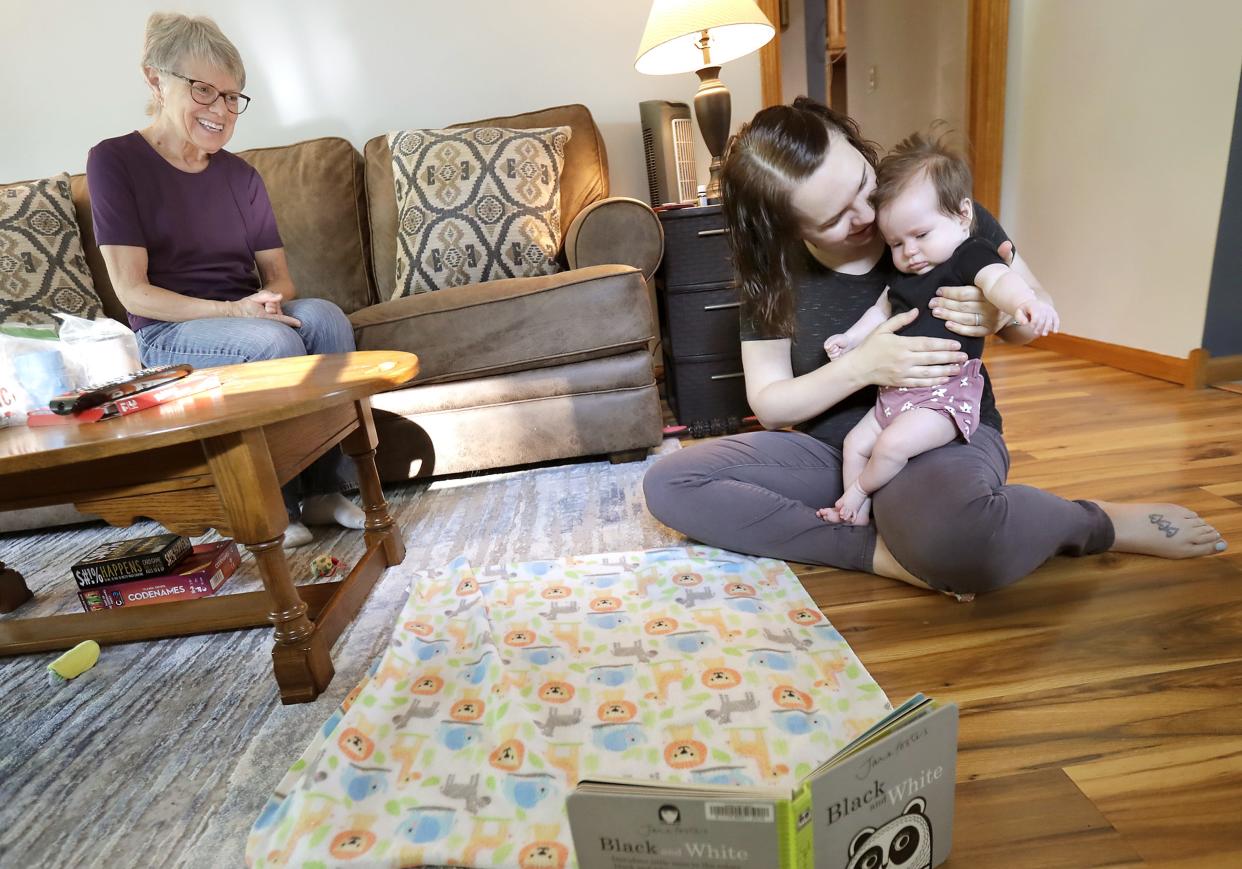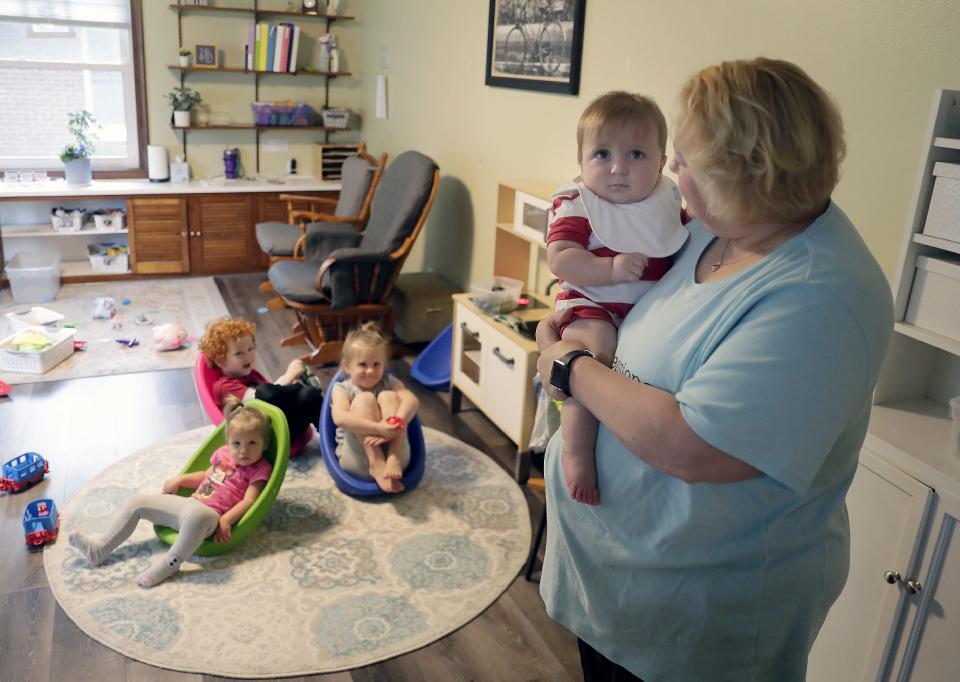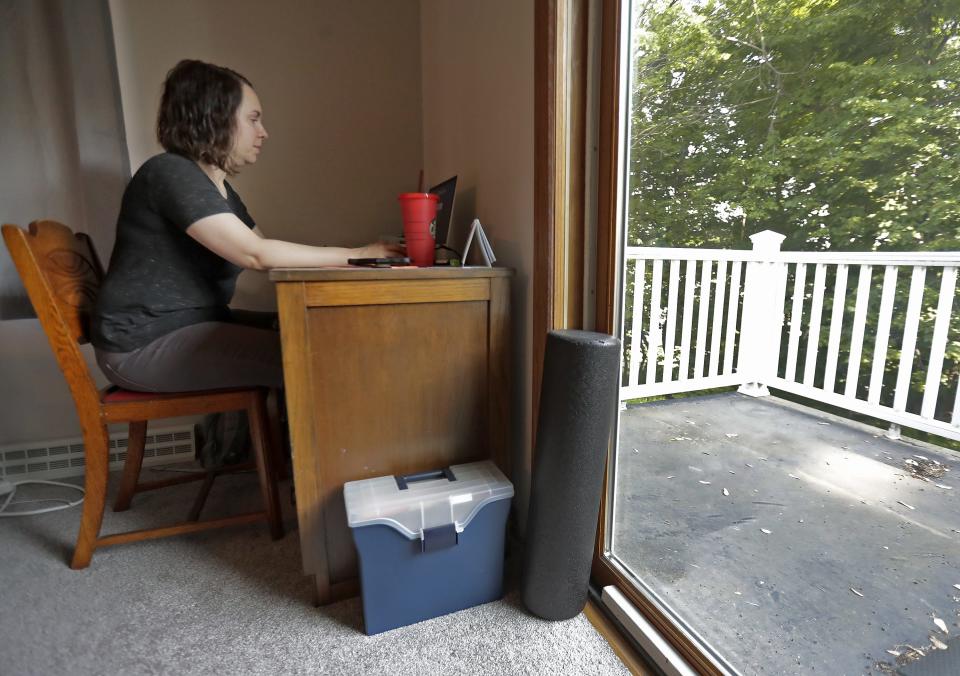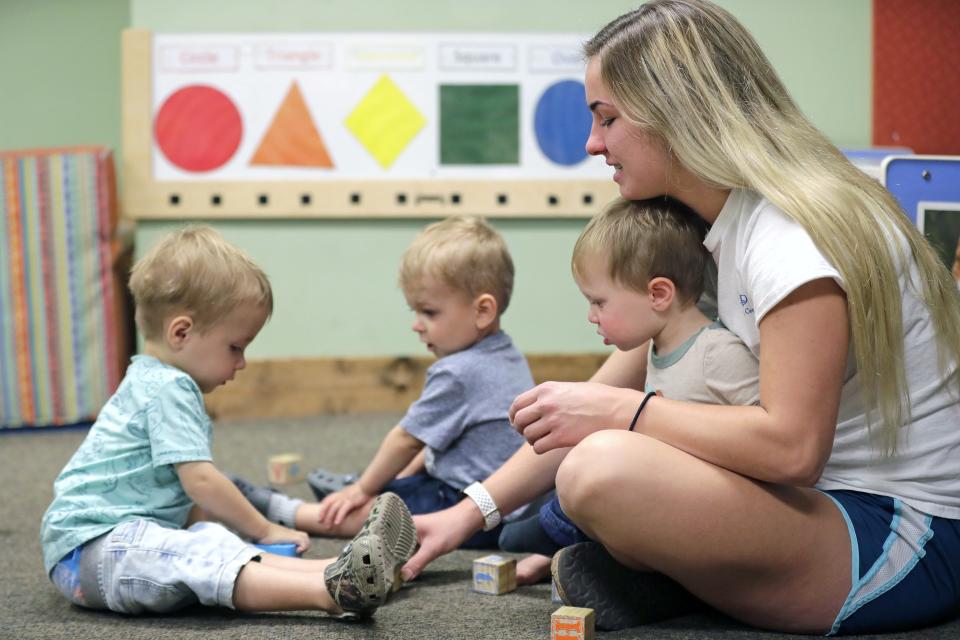Can't find child care for your infant in Wisconsin? You're not alone. Industry experts break down why it's so difficult.

This story was produced as part of the NEW (Northeast Wisconsin) News Lab, a consortium of six news outlets covering northeastern Wisconsin.
Parents have a lot to worry about when preparing for a baby: their health, hospital bills, whether or not the delivery goes smoothly — the list goes on and on. But another concern is becoming more prominent.
"(Child care) has literally been the biggest stress of my entire pregnancy — not knowing exactly where our baby is going to go, if they're going to be safe, and just knowing the waitlists are so long and the astronomical prices," said Menasha's Hannah Wainio, who's expecting her first child in late July.
Hannah and her husband, Grant, started their child care search as soon as they learned she was pregnant at five weeks. When Hannah spoke to USA TODAY NETWORK-Wisconsin in June, the family still had not found care.
Their story isn't unique. In Outagamie County, there are over 1,200 children younger than 2 on regulated child care waitlists, according to data recently compiled by Child Care Resource & Referral Fox Valley. In Winnebago County, there are nearly 550.
In Family and Child Care Resources of Northeast Wisconsin's service area, infant waitlists can span one to two years, said executive director Paula Breese. CCR&R Fox Valley's executive director, Candy Hall, said wait times can be over five years.
Because of this, it's increasingly common for parents to get on wait lists even before they conceive. Six months before Ripon's Ashley Giese found out she was expecting her fourth child, she told her child care provider she was trying to get pregnant. In New Glarus, Abby Funseth timed the conception of her second child around a child care opening.
"People plan all of the things they need and the logistics of waking up at night (to feed their infant), those are things you expect as a new parent. But you don't always expect an 18-month waiting list for daycare," Giese said.
More: The new Wisconsin family? 1.7 kids, no picket fence and child care costs more than college
Why is care for infants, specifically, so difficult to find?
The financial model most child care programs in Wisconsin operate within is flawed, said Kelly Matthews, co-director of Wisconsin Early Childhood Association's shared services network.
Aside from funds from Child Care Counts, the state's monthly stabilization payment program, which is set to expire in early 2024, the price parents pay for care is often the only revenue centers see, Matthews said. This has to cover myriad costs, including utilities, rent or mortgage, insurance, personnel costs and more.
Providers often charge parents less than the actual cost of care — all costs of running the child care facility, from bills to livable wages and benefits for the educators — in an attempt to keep prices manageable. And that's with child care workers being notoriously underpaid compared to those with similar credentials in other fields.
Child care businesses are left to survive on thin profit margins — typically 1% to 2%, while most businesses' profit margins span 10% to 20%, according to research compiled by the Greater Fox Valley Child Care Alliance.

Licensed child care programs in Wisconsin are also subject to regulations aimed at ensuring infants get age-appropriate care, Matthews said.
In a licensed family child care setting — a child care business based in the provider's home — the number of children younger than age 2 present often limits the total number of children it can serve full time, which also limits its revenue.
In group centers, staff-to-child ratios allow for more children per staff member as children get older. For example, one staff member can either supervise four children younger than 2, or six children ages 2 to 2½.
“Without (funding) based on the true cost of care, it is a better financial decision for child care programs to take children 2 and older than it is for them to take infants, which (leaves) both programs and families struggling," Matthews said. "The issue is the (lack) of revenue coming in, not the ratios."
Caring for infants is often more labor-intensive than caring for older children, as infants typically require more one-on-one interaction, according to First 5 Fox Valley Director Barb Tengesdal. It's also harder on providers' bodies, with all of the bending and lifting, according to Corrine Hendrickson, a licensed family child care provider in New Glarus.
As a result, there's often high turnover among infant teachers.
What happens when families can't find care?
Even searching for care well before their infant is due doesn't always guarantee families a spot — let alone one they can afford. According to Child Care Aware of America, the average cost of center-based infant care in Wisconsin in 2022 was $13,572, and the average price of infant care for in a family child care was $10,400. Both surpass the cost of a year of in-state tuition at University of Wisconsin-Madison.
As soon as she knew her pregnancy was viable, Allyssa Thomas, a Milwaukee-area teacher, began contacting centers, many of which required nonrefundable waitlist fees. Based on the responses, she doesn't expect a slot will open by the time her maternity leave ends.
While Thomas is confident she can piece together care for a few months if needed, she said if it takes too long, she might need to leave her job.
"I'd imagine that either myself or my husband would need to choose not to work, at least for a year while our child is still an infant, which would be hard," Thomas said. "Child care is expensive, but paying for child care with two incomes is (more feasible) than going down to one income."

Parents may also turn to their own parents when they cannot find an opening. Carolyn Nelson's mother drives five hours each week between her home in Beloit and Nelson's home in Appleton to care for Nelson's 6-month-old daughter, Emma.
This allows Nelson to continue working as a Help Me Grow navigator with ThedaCare, helping connect families with early childhood resources and information — for now. Nelson worries about what will happen if a spot doesn't open before winter, when ice and snow may prevent her mother from traveling.
"If there's still no child care, where do I put Emma every day?" Nelson asked. "Can I work through her nap times and have her home with me? To be quite honest, that sounds like I will be burnt out in two months. Would I be able to (leave work temporarily) and return once I get child care? Would that even be an option?"

On one hand, Nelson said she can't help but wish she looked sooner, starting months before Emma was born. At the same time, she knows doing so could've had unforeseen drawbacks.
"I would have been pretty crushed to get a phone call saying that there's a spot opening on a waitlist if I was no longer pregnant (due to medical complications)," Nelson said.

When parents can't find an infant opening at a high-quality child care, they may be forced to leave the workforce, turn to lower-quality options or patch care together from a variety of sources.
Tammy Dannhoff, a licensed family child care provider in Oshkosh, said consistency is key for a young child's development, and the early months and years are the prime time for children to develop secure relationships with caregivers.
This led Dannhoff to bend the rules a few summers ago to add a second child younger than 2 to her program. Under licensing regulations, she was supposed to care for only one child younger than 2 if she wanted eight slots, the maximum number a licensed family provider can have.
“When I was talking with his mom, I found out he was going to be going to three or four different places every week in the summer because she had to piece together care for him,” Dannhoff said. “At the time, he was 22 months, and I thought, ‘It’s going to be more detrimental for him to go to three or four different places for child care, so I’m going to take the risk and just take him.'”
Dannhoff was able to get an exception so she remained in compliance. Department of Children and Families Communications Director Gina Paige said there's a flow chart of sorts that helps determine when exceptions should be granted, but some family child care providers said they feel these exceptions are granted inconsistently.
What can be done?
The solution to the care shortage for children up to age 2 doesn't lie in doing away with regulations or increasing staff-to-child ratios.
"That, I believe, would be the fastest way to close down more of the under-2 rooms," said Brooke Skidmore, co-owner and director of The Growing Tree, a child care center in New Glarus. "You will not find teachers that want to have five babies under their care, and it still will not make it profitable."
Matthews thinks the solution to the infant care crisis lies in funding child care businesses based on the true cost of care.
"If we had true cost of care for payment amounts ... it would still get the bills paid and not be a loss for the program," Matthews said.

Increasing tuition rates often comes with the risk of making child care unattainable for families. Matthews said finding a path forward will require collaboration between communities, employers, families and the government.
Angel Berry, the executive director of the nonprofit A Million Dreamz child care in Sheboygan, said solutions lie in creative funding models. For example, she said, child care businesses could make infant care sustainable by operating under a nonprofit model and seeking funding support from the community.
However, in the meantime, some say slight alterations to state licensing requirements could help.
After Dannhoff investigated ways to change family child care requirements for a college capstone project in 2021, she said she supports employing a "weighted" system that distinguishes between young infants and children 18 months and older. The younger children would have a higher "weight" than the older children, essentially making a spot at a family child care available for another child once an infant turns 18-months-old instead of 2 years.
Hendrickson, who also supports this change, explained that by 18 months, children are typically more mobile and better able to verbalize their needs. The Wisconsin Family Child Care Association has long discussed the exact weights each particular age group would be assigned. As of now, however, WFCCA has not brought any formal proposals to DCF.
While Hendrickson said this change could help get families off waitlists and into consistent care more quickly, she said it alone cannot rectify Wisconsin's infant care shortage.

“It’s definitely not a solution, per se, for the crisis because it’s not going to even come close to fixing the problem, but it would be one potential way to alleviate some of the pressure," Hendrickson said.
Employers have a role to play, too. Providing and extending paid family leave gives parents essential time to bond with their infant as well as more time to search for child care, Tengesdal said. For industries in which flexible scheduling is possible, allowing parents to work from home, bring their child to work when needed, and reduced hours after birth helps both parents and babies adjust, she said.
Many of the potential solutions advocates say could bolster Wisconsin's child care sector in general would, by extension, help solve the infant care crisis, Hendrickson said. These range from significant state and federal investments to shifting the way society views child care.
"If there is no infant care, the likelihood of a mother returning to work is significantly reduced," Hendrickson said. "This impacts her family's financial wellbeing, her career trajectory, her mental health and the growth and development of her child."
This story is part of the NEW (Northeast Wisconsin) News Lab's fourth series, "Families Matter," covering issues important to families in the region. The lab is a local news collaboration in northeast Wisconsin made up of six news organizations: the Green Bay Press-Gazette, Appleton Post-Crescent, FoxValley365, The Press Times, Wisconsin Public Radio and Wisconsin Watch. The University of Wisconsin-Green Bay’s Journalism Department is an educational partner. Microsoft is providing financial support to the Greater Green Bay Community Foundation and Community Foundation for the Fox Valley Region to fund the initiative. The mission of the lab is to “collaborate to identify and fill information gaps to help residents explore ways to improve their communities and lives — and strengthen democracy.”
READ THE SERIES:
Week 14: With 'Silver Tsunami' on the horizon, condition complaints at senior living facilities surge
Week 13: Wisconsin foster children often need mental health care to thrive. Why is it hard to help them?
Week 12: Breaking the cycle: Intergenerational trauma has real impacts on lives, connections of Wisconsinites
Week 11: Rising cost of living in northeast Wisconsin has many working families treading water
Week 8: One in 5 could have dyslexia, but Wisconsin students, parents feel school support falls short
Week 7: Breaking the cycle: Addressing generational patterns key to improving quality of life
Week 6: It takes a village: How collaboration helped a small northern Wisconsin city add crucial child care
Week 5: Wisconsin families matter. Here's how 6 newsrooms, 2 community foundations and Microsoft aim to help
Week 4: Many kids missed dental care during the pandemic. Luckily, these dentists visit schools for free
Week 1: The new Wisconsin family? 1.7 kids, no picket fence and child care costs more than college
Madison Lammert covers child care and early education across Wisconsin as a Report for America corps member based at The Appleton Post-Crescent. To contact her, email mlammert@gannett.com or call 920-993-7108. Please consider supporting journalism that informs our democracy with a tax-deductible gift to Report for America
This article originally appeared on Appleton Post-Crescent: Why is it so hard to find child care for an infant in Wisconsin?

